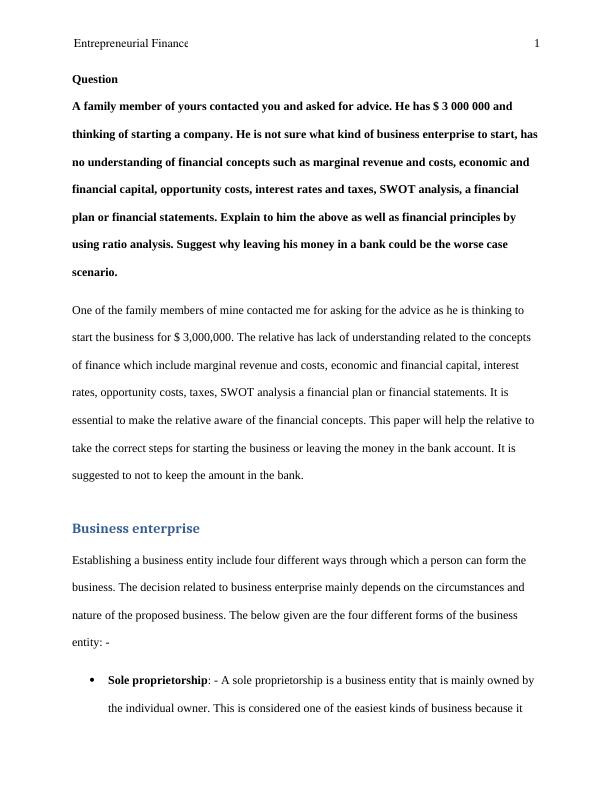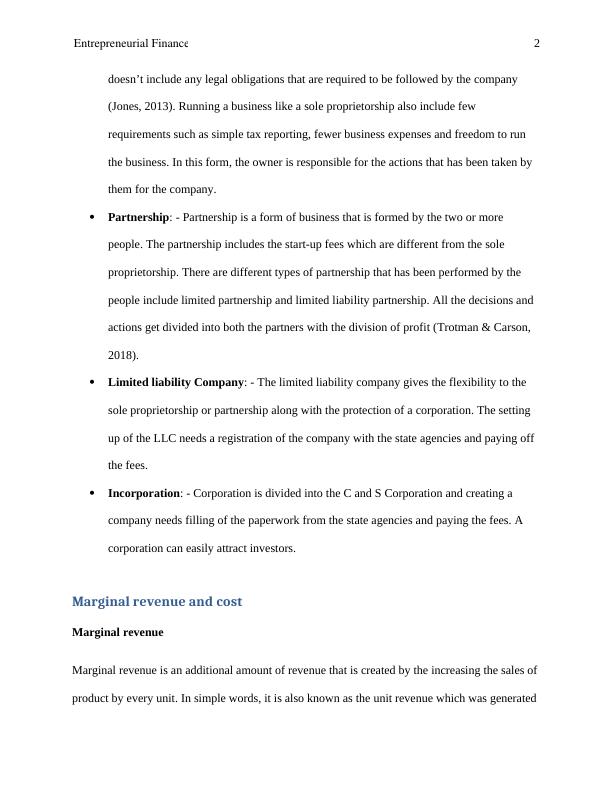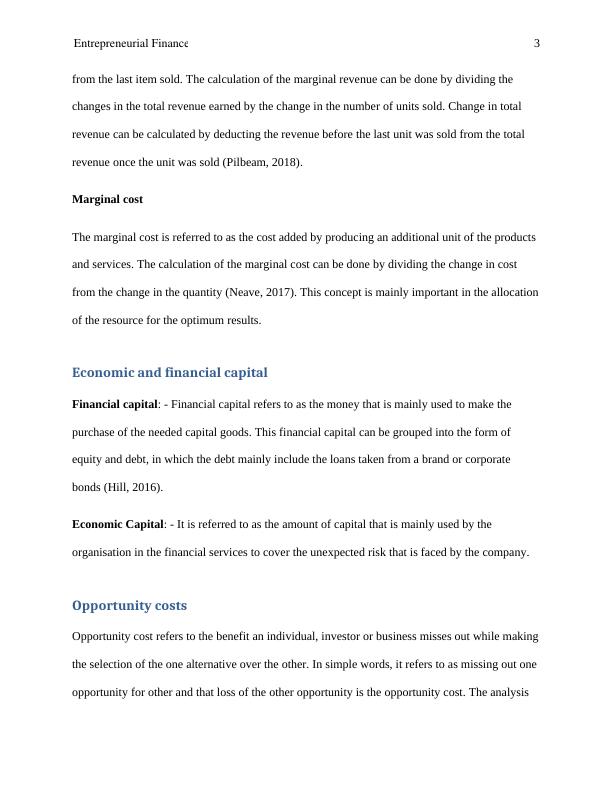Entrepreneurial Finance: Financial Principles and Ratio Analysis
Added on 2023-06-03
11 Pages2556 Words59 Views
Entrepreneurial Finance
10/20/2018
10/20/2018

1
Question
A family member of yours contacted you and asked for advice. He has $ 3 000 000 and
thinking of starting a company. He is not sure what kind of business enterprise to start, has
no understanding of financial concepts such as marginal revenue and costs, economic and
financial capital, opportunity costs, interest rates and taxes, SWOT analysis, a financial
plan or financial statements. Explain to him the above as well as financial principles by
using ratio analysis. Suggest why leaving his money in a bank could be the worse case
scenario.
One of the family members of mine contacted me for asking for the advice as he is thinking to
start the business for $ 3,000,000. The relative has lack of understanding related to the concepts
of finance which include marginal revenue and costs, economic and financial capital, interest
rates, opportunity costs, taxes, SWOT analysis a financial plan or financial statements. It is
essential to make the relative aware of the financial concepts. This paper will help the relative to
take the correct steps for starting the business or leaving the money in the bank account. It is
suggested to not to keep the amount in the bank.
Business enterprise
Establishing a business entity include four different ways through which a person can form the
business. The decision related to business enterprise mainly depends on the circumstances and
nature of the proposed business. The below given are the four different forms of the business
entity: -
Sole proprietorship: - A sole proprietorship is a business entity that is mainly owned by
the individual owner. This is considered one of the easiest kinds of business because it
Question
A family member of yours contacted you and asked for advice. He has $ 3 000 000 and
thinking of starting a company. He is not sure what kind of business enterprise to start, has
no understanding of financial concepts such as marginal revenue and costs, economic and
financial capital, opportunity costs, interest rates and taxes, SWOT analysis, a financial
plan or financial statements. Explain to him the above as well as financial principles by
using ratio analysis. Suggest why leaving his money in a bank could be the worse case
scenario.
One of the family members of mine contacted me for asking for the advice as he is thinking to
start the business for $ 3,000,000. The relative has lack of understanding related to the concepts
of finance which include marginal revenue and costs, economic and financial capital, interest
rates, opportunity costs, taxes, SWOT analysis a financial plan or financial statements. It is
essential to make the relative aware of the financial concepts. This paper will help the relative to
take the correct steps for starting the business or leaving the money in the bank account. It is
suggested to not to keep the amount in the bank.
Business enterprise
Establishing a business entity include four different ways through which a person can form the
business. The decision related to business enterprise mainly depends on the circumstances and
nature of the proposed business. The below given are the four different forms of the business
entity: -
Sole proprietorship: - A sole proprietorship is a business entity that is mainly owned by
the individual owner. This is considered one of the easiest kinds of business because it

2
doesn’t include any legal obligations that are required to be followed by the company
(Jones, 2013). Running a business like a sole proprietorship also include few
requirements such as simple tax reporting, fewer business expenses and freedom to run
the business. In this form, the owner is responsible for the actions that has been taken by
them for the company.
Partnership: - Partnership is a form of business that is formed by the two or more
people. The partnership includes the start-up fees which are different from the sole
proprietorship. There are different types of partnership that has been performed by the
people include limited partnership and limited liability partnership. All the decisions and
actions get divided into both the partners with the division of profit (Trotman & Carson,
2018).
Limited liability Company: - The limited liability company gives the flexibility to the
sole proprietorship or partnership along with the protection of a corporation. The setting
up of the LLC needs a registration of the company with the state agencies and paying off
the fees.
Incorporation: - Corporation is divided into the C and S Corporation and creating a
company needs filling of the paperwork from the state agencies and paying the fees. A
corporation can easily attract investors.
Marginal revenue and cost
Marginal revenue
Marginal revenue is an additional amount of revenue that is created by the increasing the sales of
product by every unit. In simple words, it is also known as the unit revenue which was generated
doesn’t include any legal obligations that are required to be followed by the company
(Jones, 2013). Running a business like a sole proprietorship also include few
requirements such as simple tax reporting, fewer business expenses and freedom to run
the business. In this form, the owner is responsible for the actions that has been taken by
them for the company.
Partnership: - Partnership is a form of business that is formed by the two or more
people. The partnership includes the start-up fees which are different from the sole
proprietorship. There are different types of partnership that has been performed by the
people include limited partnership and limited liability partnership. All the decisions and
actions get divided into both the partners with the division of profit (Trotman & Carson,
2018).
Limited liability Company: - The limited liability company gives the flexibility to the
sole proprietorship or partnership along with the protection of a corporation. The setting
up of the LLC needs a registration of the company with the state agencies and paying off
the fees.
Incorporation: - Corporation is divided into the C and S Corporation and creating a
company needs filling of the paperwork from the state agencies and paying the fees. A
corporation can easily attract investors.
Marginal revenue and cost
Marginal revenue
Marginal revenue is an additional amount of revenue that is created by the increasing the sales of
product by every unit. In simple words, it is also known as the unit revenue which was generated

3
from the last item sold. The calculation of the marginal revenue can be done by dividing the
changes in the total revenue earned by the change in the number of units sold. Change in total
revenue can be calculated by deducting the revenue before the last unit was sold from the total
revenue once the unit was sold (Pilbeam, 2018).
Marginal cost
The marginal cost is referred to as the cost added by producing an additional unit of the products
and services. The calculation of the marginal cost can be done by dividing the change in cost
from the change in the quantity (Neave, 2017). This concept is mainly important in the allocation
of the resource for the optimum results.
Economic and financial capital
Financial capital: - Financial capital refers to as the money that is mainly used to make the
purchase of the needed capital goods. This financial capital can be grouped into the form of
equity and debt, in which the debt mainly include the loans taken from a brand or corporate
bonds (Hill, 2016).
Economic Capital: - It is referred to as the amount of capital that is mainly used by the
organisation in the financial services to cover the unexpected risk that is faced by the company.
Opportunity costs
Opportunity cost refers to the benefit an individual, investor or business misses out while making
the selection of the one alternative over the other. In simple words, it refers to as missing out one
opportunity for other and that loss of the other opportunity is the opportunity cost. The analysis
from the last item sold. The calculation of the marginal revenue can be done by dividing the
changes in the total revenue earned by the change in the number of units sold. Change in total
revenue can be calculated by deducting the revenue before the last unit was sold from the total
revenue once the unit was sold (Pilbeam, 2018).
Marginal cost
The marginal cost is referred to as the cost added by producing an additional unit of the products
and services. The calculation of the marginal cost can be done by dividing the change in cost
from the change in the quantity (Neave, 2017). This concept is mainly important in the allocation
of the resource for the optimum results.
Economic and financial capital
Financial capital: - Financial capital refers to as the money that is mainly used to make the
purchase of the needed capital goods. This financial capital can be grouped into the form of
equity and debt, in which the debt mainly include the loans taken from a brand or corporate
bonds (Hill, 2016).
Economic Capital: - It is referred to as the amount of capital that is mainly used by the
organisation in the financial services to cover the unexpected risk that is faced by the company.
Opportunity costs
Opportunity cost refers to the benefit an individual, investor or business misses out while making
the selection of the one alternative over the other. In simple words, it refers to as missing out one
opportunity for other and that loss of the other opportunity is the opportunity cost. The analysis

End of preview
Want to access all the pages? Upload your documents or become a member.
Related Documents
Types of Business Enterprise: Sole Proprietorship, Partnership, and Limited Liability Companylg...
|6
|1349
|338
Accounting for Business Decisions - Presentationlg...
|12
|309
|26
Accounting for Business Decisionslg...
|7
|1290
|350
Accounting for Businesslg...
|8
|1531
|87
Form of Organisation and Legal Issueslg...
|6
|1355
|113
ACCOUNTING FOR BUSINESS.lg...
|8
|1450
|90
